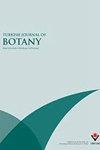牛至精油对人源细胞系的体外生理作用
IF 1.5
4区 生物学
Q3 PLANT SCIENCES
引用次数: 0
摘要
:牛至属于Lamiaceae科,在土耳其民族植物学研究和公众中常用于胃肠道、内分泌和呼吸系统疾病的对症治疗。在本研究中,我们的目的是研究O.onites精油(OE)对A549人肺癌癌症、MIA-PaCa人胰腺癌症和HUVEC人内皮细胞系的生理作用。我们的研究结果表明,所有浓度(4.79–191.6µg/mL,24小时)的O.onites OE处理都可以抑制A549和MIA-PaCa细胞系的细胞增殖并诱导细胞凋亡(P<0.0001)。尽管≤19.16µg/mL的OE处理24小时没有抑制HUVEC细胞系中的细胞增殖,但较高浓度的OE(≥38.32µg/mL)显著抑制了细胞增殖。在两个孵育时间,所有细胞系的凋亡细胞计数均显著(P<0.0001)较高(A549为24小时56.3±7%,48小时53±5%,MIA-PaCa为24小时44±7%,48h 44.7±7%,HUVEC为24小时48.7±6%,48小时49.3±5%)。迁移率显著降低(P<0.0001)(A549为24 h 64±6%,48 h 67.2±4%,MIA-PaCa为24 h 49±5%,48 h 69.35±5%,HUVEC为24 h 47±5%,48h 69.6±2%)。基于这些结果,OE已被证明具有良好的抗癌效果。本文章由计算机程序翻译,如有差异,请以英文原文为准。
In vitro physiological effects of Origanum onites L. (Lamiaceae) essential oil treatment on human origin cell lines
: Origanum onites L. belongs to the Lamiaceae family which is commonly used for symptomatic treatment of the diseases of the gastrointestinal, endocrine, and respiratory systems in Turkish ethnobotanical studies and public. In this study our aim was to investigate the physiological effects of O. onites essential oil (OE) on A549 human lung cancer, MIA PaCa human pancreas cancer and HUVEC human endothelial cell lines. Our findings showed that O. onites OE treatment at all concentrations (4.79–191.6 µg/mL, 24 h) can inhibit cell proliferation and induce apoptosis in A549 and MIA PaCa cell lines (P < 0.0001). Although ≤19.16 µg/mL OE treatment for 24 h did not inhibit cell proliferation in the HUVEC cell lines, higher concentrations of OE (≥38.32 µg/mL) significantly inhibited cell proliferation. Apoptotic cell counts were significantly (P < 0.0001) higher in all cell lines at both incubation times (24 h 56.3 ± 7%, 48 h 53 ± 5% for A549, 24 h 44 ± 7%, 48 h 44.7 ± 7% for MIA PaCa, 24 h 48.7 ± 6%, 48 h 49.3 ± 5% for HUVEC). Migration rates were decreased significantly (P < 0.0001) (24 h 64 ± 6%, 48 h 67.2 ± 4% for A549, 24 h 49 ± 5%, 48 h 69.35 ± 5% for MIA PaCa, 24 h 47 ± 5%, 48 h 69.6 ± 2% for HUVEC). Based on these results, OE has been shown to have promising anticancer effects.
求助全文
通过发布文献求助,成功后即可免费获取论文全文。
去求助
来源期刊

Turkish Journal of Botany
PLANT SCIENCES-
CiteScore
2.90
自引率
5.60%
发文量
31
审稿时长
6-12 weeks
期刊介绍:
The Turkish Journal of Botany is published electronically 6 times a year by the Scientific and Technological Research Council of Turkey (TÜBİTAK) and accepts manuscripts (in English) covering all areas of plant biology (including genetics, evolution, systematics, structure, function, development, diversity, conservation biology, biogeography, paleobotany, ontogeny, functional morphology, ecology, reproductive biology, and pollination biology), all levels of organisation (molecular to ecosystem), and all plant groups and allied organisms (algae, fungi, and lichens). Authors are required to frame their research questions and discuss their results in terms of major questions in plant biology. In general, papers that are too narrowly focused, purely descriptive, or broad surveys, or that contain only preliminary data or natural history, will not be considered (*).
The following types of article will be considered:
1. Research articles: Original research in various fields of botany will be evaluated as research articles.
2. Research notes: These include articles such as preliminary notes on a study or manuscripts on the morphological, anatomical, cytological, physiological, biochemical, and other properties of plant, algae, lichen and fungi species.
3. Reviews: Reviews of recent developments, improvements, discoveries, and ideas in various fields of botany.
4. Letters to the editor: These include opinions, comments relating to the publishing policy of the Turkish Journal of Botany, news, and suggestions. Letters should not exceed one journal page.
(*) 1. Raw floristic lists (of algae, lichens, fungi, or plants), species descriptions, chorological studies, and plant sociology studies without any additional independent approaches.
2. Comparative morphology and anatomy studies (that do not cover a family, tribe, subtribe, genus, subgenus, section, subsection, or species complexes with taxonomical problems) without one or more independent additional approaches such as phylogenetical, micromorphological, chromosomal and anatomical analyses.
3. Revisions of family, tribe, genus, subgenus, section, subsection, or species complexes without any original outputs such as taxonomical status changes, IUCN categories, and phenological and ecological analyses.
4. New taxa of all plants without any additional independent approaches such as phylogenetical, ecological, chromosomal, chorological and correlational analyses in addition to a detailed macro- and micro-morphological descriptions with quality field and microscopic illustrations of taxonomically important structures and identification key in the taxonomic group.
New records of all plants without any additional independent approaches such as phylogenetical, ecological, chromosomal, chorological and correlational analyses in addition to a detailed macro- and micro-morphological descriptions with quality field and microscopic illustrations of taxonomically important structures and identification key in the taxonomic group may be accepted for peer review if they contain 3 or more new records or taxonomical status update, such as lectotypification, new combinations, transfers, revivals and synonyms.
5. New taxa of algae, lichens, and fungi without any additional independent approaches such as phylogenetical, ecological, chromosomal, chorological and correlational analyses in addition to a detailed macro- and micro-morphological descriptions with quality field and microscopic illustrations of taxonomically important structures and identification key in the taxonomic group.
New records of algae, lichens, and fungi without any additional independent approaches such as phylogenetical, ecological, chromosomal, chorological and correlational analyses in addition to a detailed macro- and micro-morphological descriptions with quality field and microscopic illustrations of taxonomically important structures and identification key in the taxonomic group may be accepted for peer review if they contain 5 or more new records or taxonomical status update, such as lectotypification, new combinations, transfers, revivals and synonyms.
 求助内容:
求助内容: 应助结果提醒方式:
应助结果提醒方式:


